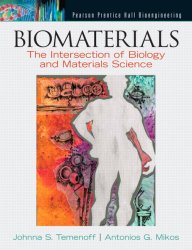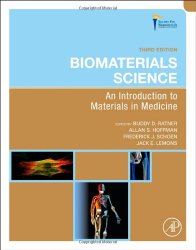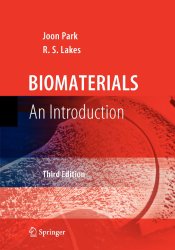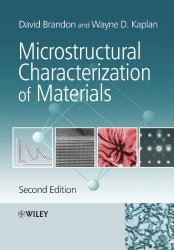 Biomaterials: The Intersection of Biology and Materials Science
Biomaterials: The Intersection of Biology and Materials Scienceby Johnna S. Temenoff, Antonios G. Mikos
Publisher: Prentice Hall
ISBN: 0130097101
Intended for use in an introductory course on biomaterials, taught primarily in departments of biomedical engineering. The book covers classes of materials commonly used in biomedical applications, followed by coverage of the biocompatibility of those materials with the biological environment.
Finally, it covers some in-depth applications of biomaterials. It does all of this with an overall emphasis on tissue engineering.
 Biomaterials Science
Biomaterials Scienceby Buddy D. Ratner, Allan S. Hoffman, Frederick J. Schoen, Jack E. Lemons, Fredenck J. Scheon
Publisher: Academic Press
ISBN: 0123746264
All aspects of biomaterials science are thoroughly addressed, from tissue engineering to cochlear prostheses and drug delivery systems. Over 80 contributors from academia, government and industry detail the principles of cell biology, immunology, and pathology. Focus within pertains to the clinical uses of biomaterials as components in implants, devices, and artificial organs. This reference also touches upon their uses in biotechnology as well as the characterization of the physical, chemical, biochemical and surface properties of these materials.
In this presentation, which aims for a balanced introduction to the field, chapters on properties of materials and classes of materials used in medicine are followed by discussion of concepts of biology, biochemistry, and medicine, and practical aspects--host reactions to biomaterials and their evaluation, degradation of materials in the biological environment, artificial organs, implants and devices, and new products and standards.
 Biomaterials: An Introduction
Biomaterials: An Introductionby Joon Park, R. S. Lakes
Publisher: Springer
ISBN: 1441922814
Biomaterials, an Introduction is intended as a general introduction to the uses of artificial materials in the human body for the purposes of aiding healing, correcting deformities, and restoring lost function.
Enhancing on the field developments since the successful last edition, Biomaterials, an Introduction continues in its tradition as an outgrowth of an undergraduate course for senior students in biomedical engineering developed by the authors With 60 years of combined experience, the authors have emphasized the fundamental materials science, structure-property relationships and biological responses as a foundation for a wide array of biomaterials applications.
 An Introduction to Tissue-Biomaterial Interactions
An Introduction to Tissue-Biomaterial Interactionsby Kay C. Dee, David A. Puleo, Rena Bizios
Publisher: Wiley-Liss
ISBN: 0471253944
An Introduction to Tissue-Biomaterial Interactions acquaints an undergraduate audience with the fundamental biological processes that influence these sophisticated, cutting-edge procedures. Chapters one through three provide more detail about the molecular-level events that happen at the tissue-implant interface, while chapters four through ten explore selected material, biological, and physiological consequences of these events.
The importance of the body’s wound-healing response is emphasized throughout. Specific topics covered include:Structure and properties of biomaterials
 Biomaterials, artificial organs and tissue engineering
Biomaterials, artificial organs and tissue engineeringby Larry Hench, Julian Jones
Publisher: Woodhead Publishing
ISBN: 185573737X
This textbook and collection of illustrated CD lectures summarizes how maintaining quality of life in an aging population is being achieved by the development of specialty biomaterials, devices, artificial organs, and in vitro growth of human cells as tissue engineered constructs.
Following an introduction to living and man-made materials, the book discusses clinical applications of biomaterials and devices, summarizes the bioengineering principles and materials used in artificial organs, and presents the concepts and applications of tissue engineering.
 Forensic Engineering Fundamentals
Forensic Engineering Fundamentals Microstructural Characterization of Materials
Microstructural Characterization of Materials Nanostructures and Nanomaterials: Synthesis, Properties, and Applications
Nanostructures and Nanomaterials: Synthesis, Properties, and Applications